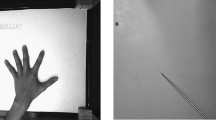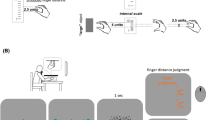Abstract.
The task of reaching with a hand toward a target given in space is generally described as an ill-posed problem. It is often assumed that some kind of internal body model is required to solve this problem. This article provides information concerning the nature of this representation. Experiments were carried out in which blindfolded subjects were stimulated mechanically at one of eight possible stimulation sites on the legs and then asked to move one hand as quickly as possible to the stimulated site. In nine different postures of legs and hands, the frequency was recorded of the use of either hand. In addition, reaction times (RT) were measured and in two choice reaction tasks RTs were measured for different conditions (morphologically compatible vs morphologically incompatible, hands parallel vs hands crossed): The results support the hypothesis that the representation of the body is based on at least two systems, one which provides spatial information concerning the body position and a second one which is based on a morphological representation. According to this hypothesis, our results could be described by the following schema. Following the application of the stimulus, two processes were started in parallel. One concerned the activation of the spatial representation of body position, including the position of stimulus site and the possible response sites. This was more difficult, i.e., took more time, when the hands were crossed. Within this spatial representation, the distances between stimulus site and response sites were determined, and it was found that the smaller the distance, the more strongly the hands were activated. Simultaneously, in a second process the response site which was morphologically ipsilateral to the stimulus was excited. This schema could explain our results: In the behavioral experiments that hand which was most strongly excited, and which therefore exceeded a threshold sooner, won the decision and showed smaller RT values. In the choice reaction experiments, the winning hand was compared with the externally given task. The more strongly, according to the given task, the wrong hand was excited, the longer was the RT of the response.
Similar content being viewed by others
Author information
Authors and Affiliations
Additional information
Electronic Publication
Rights and permissions
About this article
Cite this article
Kim, DH., Cruse, H. Two kinds of body representation are used to control hand movements following tactile stimulation. Exp Brain Res 139, 76–91 (2001). https://doi.org/10.1007/s002210100741
Received:
Accepted:
Issue Date:
DOI: https://doi.org/10.1007/s002210100741




